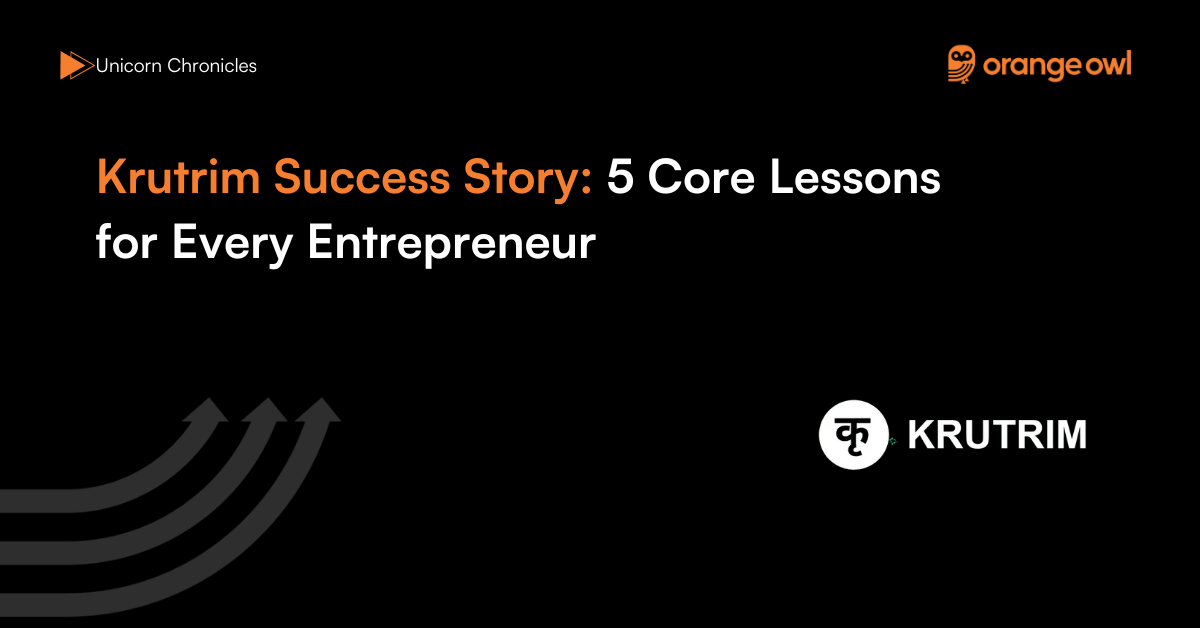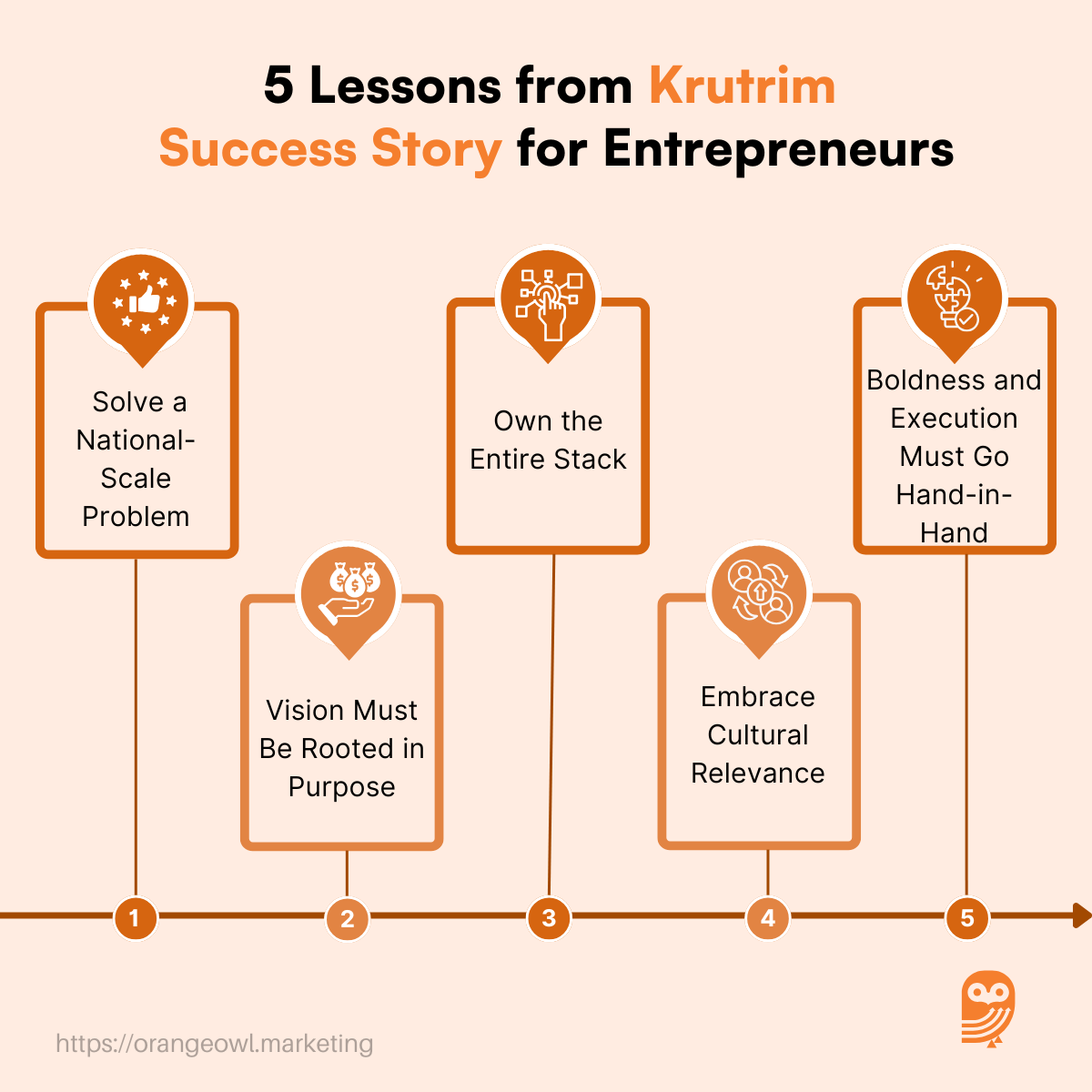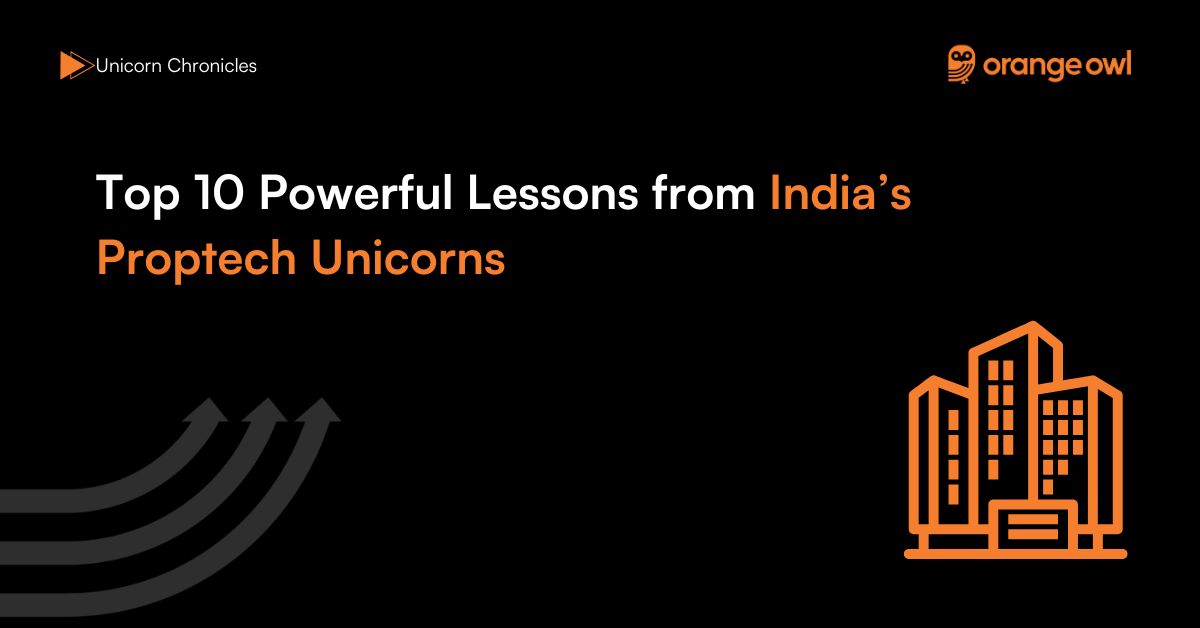Krutrim Success Story: 5 Core Lessons for Every Entrepreneur
Vivek Goel
June 6, 2025

Table of Contents
Introduction
In an era where Artificial Intelligence (AI) is redefining the future of global economies, India has found its own visionary challenger in Krutrim, an AI startup founded by Bhavish Aggarwal, also the co-founder of Ola.
Launched in December 2023, Krutrim swiftly achieved unicorn status by January 2024, securing $50 million in funding at a valuation of $1 billion. This milestone not only made Krutrim India’s first AI unicorn but also underscored the nation’s growing prowess in the AI sector.
Krutrim’s ambition extends beyond mere valuation. The company aims to build a comprehensive AI computing stack tailored for India, encompassing indigenous data centers, servers, and supercomputers.
“With AI defining the future paradigms of economy and culture, it is important for our nation to take leadership in AI. More importantly, it is extremely essential to have an AI that is Indian at heart, stays true to our Indian cultural ethos and solves real Indian problems.” — Bhavish Aggarwal
Origin Story
The seed for Krutrim was sown from Bhavish Aggarwal’s deep conviction that India must shift from being a passive technology consumer to an active global innovator. After revolutionizing urban mobility with Ola and launching Ola Electric to drive EV adoption in India, Bhavish turned his sights toward the next great technological frontier — Artificial Intelligence.
His growing concern was that while India generates a significant portion of the world’s digital data, most of it is being processed and monetized outside the country by global tech giants.
This realization ignited the vision for Krutrim — which means “artificial” in Sanskrit — as a platform to reclaim India’s digital sovereignty and build foundational AI tools tailored specifically for Indian contexts. Krutrim is not just a product; it’s a movement. It aims to represent India’s multilingualism, cultural nuance, and indigenous data through technology.
Bhavish’s passion is clear when he says:
“Today we produce 20 percent of the world’s digital data… Ninety percent is exported into global data centers owned by Big Tech, processed into AI, and sold back to us in dollars. It’s exactly what happened 200 years ago with the East India Company.”
This powerful analogy highlights the urgency of building homegrown AI infrastructure to prevent a repeat of historical patterns — where India is rich in resources but loses out on value creation. Krutrim was created to flip that script.
Business Landscape and Early Challenges
When Krutrim entered India’s AI market in 2023, it stepped into a space already saturated with global AI giants like OpenAI’s ChatGPT, Google’s Gemini, and Meta’s LLaMA models.
These platforms had years of research, deep-pocketed backers, and access to some of the world’s largest language datasets. In contrast, India had very few foundational models or indigenous efforts that reflected local languages, cultural intricacies, or societal needs.
Krutrim chose not to simply replicate Western AI. Instead, it committed to building an entirely full-stack AI ecosystem from the ground up — a massive and ambitious undertaking. The company’s early goals were defined by four pillars:
- Developing large language models (LLMs) trained on Indian datasets, which include Indic languages, regional dialects, and culturally contextual content.
- Centering Indian languages by prioritizing Hindi, Tamil, Kannada, Marathi, Bengali, and more — a crucial move considering that over 88% of Indians are non-English speakers.
- Ensuring privacy and data sovereignty, with all AI development and data storage remaining within Indian borders.
- Building indigenous compute infrastructure, including data centers and chips optimized for AI workloads.
Krutrim launched its first multilingual LLM in December 2023 and claimed it outperformed existing models in Indian language benchmarks.
According to Bhavish:
“Krutrim marks the beginning of a new era of computing in India. The model is trained on large Indian data sets and is deeply rooted into Indian values.”
However, building from scratch came with intense capital demands, talent scarcity in India’s deep-tech sector, and infrastructure gaps. Despite this, Krutrim made remarkable strides within months, signaling the dawn of India’s AI independence.
Growth Strategies
Krutrim’s growth is rooted in a bold vision to make India a self-reliant AI powerhouse, and its strategic moves reflect this ambition. One of its most notable milestones was the launch of its first large language model (LLM) in December 2023 — trained on Indian languages and datasets.
This foundational step was followed by the announcement of Krutrim Pro, an upgraded model expected in mid-2024, designed to better understand the linguistic diversity, cultural nuance, and societal dynamics of India.
Unlike generic AI models trained primarily on English or Western datasets, Krutrim Pro is optimized to work seamlessly in Hindi, Tamil, Kannada, Marathi, Bengali, and many more native tongues.
Another critical pillar of growth lies in hardware-software integration. Bhavish Aggarwal understands that India cannot achieve true AI independence unless it also controls the infrastructure.
Krutrim has set plans in motion to build indigenous data centers and cloud computing systems, ensuring that the massive amount of Indian data stays within national borders and is used to generate value domestically, rather than being siphoned off by foreign-owned tech companies.
To support these ambitions, hiring top talent has been a priority. Krutrim has begun assembling a world-class team of AI researchers, engineers, and data scientists, both from within India and through international recruitment. This infusion of intellectual capital is vital for developing not only robust models but also AI chips and tools tailored to India’s digital landscape.
Moreover, Krutrim’s growth is deeply integrated with the Ola ecosystem, which includes Ola Electric and Ola Cabs. The long-term plan is to embed Krutrim AI in Ola’s EVs and smart devices, creating a seamless interface between India’s mobility platforms and its AI future. Whether it’s voice commands, real-time route optimization, or predictive diagnostics, Krutrim aims to power next-gen transportation experiences.
As Bhavish states:
“Our ambition is to build a globally competitive and futuristic transportation system in India that will support and accelerate a nation on the move.”
Marketing Strategies
Krutrim’s marketing is not just about creating brand recall — it’s about igniting a national movement. The startup has positioned itself as a symbol of India’s technological resurgence, weaving its narrative into the larger goals of digital sovereignty, cultural pride, and innovation leadership.
This is reflected in the way Bhavish Aggarwal himself leads the communication front — actively engaging with audiences via LinkedIn posts, keynote addresses, YouTube demo videos, and community-building events. His persona, deeply nationalistic and tech-forward, has become synonymous with the brand.
Instead of expensive media campaigns, Krutrim leans into thought leadership. Whether through public speeches, media interviews, or panel discussions, Bhavish continues to articulate a compelling vision for India’s AI roadmap. His talks not only inspire but educate the public on the importance of homegrown AI.
Another standout strategy is transparency. Krutrim has consistently shared its product demos, research progress, and development goals through publicly accessible content. The demo videos showcasing Krutrim’s capabilities in understanding Indian queries and dialects have generated significant buzz and trust. This openness stands in contrast to the opaque development cycles of many global AI firms.
Most importantly, Krutrim taps into national sentiment. Just as India takes pride in ISRO’s space achievements or strides in semiconductor self-sufficiency, Krutrim positions itself as the AI equivalent of these national missions. The narrative is clear: this is India building its own future, with its own tools, in its own languages
5 Core Lessons Every Entrepreneur Should Learn
1. Solve a National-Scale Problem
Krutrim wasn’t founded to simply ride the AI wave; it was born from a powerful realization — that India needed to reclaim control over its digital data and AI future. Bhavish Aggarwal identified a national-scale problem: India, despite producing over 20% of the world’s digital data, was letting that data be processed and monetized abroad. Krutrim’s mission to solve this reflects more than business acumen — it’s a call for digital sovereignty.
Lesson: As an entrepreneur, aim to solve meaningful, large-scale challenges. When your mission resonates with a nation’s needs and aspirations, you’re not just building a company — you’re building a movement.
2. Vision Must Be Rooted in Purpose
From the beginning, Krutrim has carried a deep sense of purpose — to represent Indian voices, culture, and values in the global AI conversation. Bhavish Aggarwal’s clarity and conviction in this vision have served as a north star for the company. Even while global giants dominate AI development, Krutrim stands out because it is deeply intentional, not opportunistic.
Lesson: A long-term, purpose-driven vision is more resilient than one based on trends. When you define your “why,” it helps you weather market changes and align every team and decision toward a meaningful goal.

3. Own the Entire Stack
Most AI startups focus on software, but Krutrim goes beyond — building India’s own LLM, setting up indigenous data centers, and even exploring chip development. This vertical integration ensures that India doesn’t stay dependent on foreign infrastructure to achieve AI success. It’s a bold move, but one that aligns perfectly with the vision of self-reliance.
Lesson: Don’t wait for ideal conditions. If the ecosystem you need doesn’t exist, build it yourself. When your mission demands autonomy, full-stack ownership is not a luxury — it’s a necessity.
4. Embrace Cultural Relevance
While most global AI models fail to grasp Indian social cues, dialects, or contexts, Krutrim is built with an Indian soul. By training its models on native languages, Indian news, literature, and social behavior, it becomes naturally more aligned with the Indian user. This isn’t just technical differentiation — it’s emotional connection.
Lesson: Deep localization isn’t optional. It’s how brands build trust, relevance, and long-term user engagement. Whether you’re building for India or another market, culture isn’t a constraint — it’s a competitive edge.
5. Boldness and Execution Must Go Hand-in-Hand
Launching an AI venture while running Ola and Ola Electric might seem overwhelming to most, but Bhavish Aggarwal thrives under the weight of big visions. His ability to push boundaries, take calculated risks, and maintain speed is a testament to executional excellence. Krutrim went from idea to live demo in less than a year — a feat few startups can claim.
Lesson: Bold ideas are only the starting point. Real impact comes from relentless execution — the discipline to build, ship, learn, and improve at breakneck speed. Success belongs to those who act, not just ideate.
Conclusion
Krutrim is not just another AI startup — it is a bold declaration of India’s intent to shape its own technological destiny. In an industry largely dominated by Western giants, Krutrim represents a unique voice — one that is Indian at its core, focused on solving problems that matter most to the nation.
From building its own LLM to developing indigenous data infrastructure, every step the company takes is rooted in the belief that India must not be a passive consumer of global technologies, but an active architect of its future.
Bhavish Aggarwal and his team have proven that purpose-driven innovation, when backed by relentless execution, can overcome even the most entrenched challenges. By embracing cultural authenticity, technological independence, and long-term vision, Krutrim is laying the groundwork for a future where AI understands and empowers over a billion Indians in their own languages and context.
For entrepreneurs, Krutrim’s story is more than a business case study — it is a call to dream big and build boldly. It reminds us that disruption doesn’t always come from Silicon Valley — sometimes, it rises from within, when a founder dares to believe that their country can lead the next revolution.
“It’s time for India to own its future in AI — not borrow it.”— Bhavish Aggarwal


